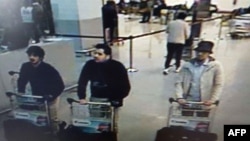Security agencies racing to break the web of Islamic State (IS) terror cells that have spread across the European continent are also bracing for another worrisome possibility - that the group will use guerrilla tactics honed in Syria and Iraq to carry out attacks on critical targets or infrastructure.
Concerns have been heightened in recent days, most notably with the revelation that a laptop found during a raid connected to the suspects in the Brussels terror bombings contained images and floor plans of the office of Belgium’s prime minister.
That, along with evidence that two of the Brussels bombers, Khalid and Ibrahim el Bakraoui, conducted video surveillance of a scientist at Belgium’s Tihange nuclear complex, could suggest some terror cells are prepared to abandon the group's hallmark attacks on so-called “soft targets” like train stations or cafes, in favor of bigger, more symbolic venues.
“They’re very invested in the pageantry of it all so I wouldn’t be surprised,” said one U.S. official familiar with the intelligence on IS. “They’re unambiguous about seeing Europe as a battlefield.”
European officials are equally worried, especially given that the ability to detect and disrupt potential plots varies greatly country to country.
“We still have a very high level of concern for new terror attacks,” a Western diplomat told VOA, speaking on condition of anonymity. “The level of engagement and commitment to discover potential attacks is very high.”
Adding to the concerns is IS’s growing ability to use the Internet to share intelligence between its core leadership and provinces and cells around the world.
“ISIS now has mastered online dissemination of all their combat lessons learned,” said Malcolm Nance, a former counterterrorism and intelligence officer who now heads the Terror Asymmetrics Project (TAPSTRI).
“We’re seeing vehicle designs of these technical vehicles with armor plating that we see in combat in Ramadi showing up in Benghazi, showing up in Somalia,” he said. “And all of their intelligence sharing is happening at a very rudimentary level, and it’s very hard to intercept."
European network
Initially, intelligence concerns about additional attacks centered on IS terrorists using November’s attacks in Paris as a blueprint, hitting multiple “soft targets” simultaneously, maximizing civilian casualties. But the Brussels attacks that killed 32 people suggest the terror group is growing bolder.
“What it says is that our enemy has a network that seems to be active and thriving in the heart of Europe,” former CIA director, Gen. Michael Hayden told VOA. “The level of sophistication, kind of continuing on that same arc, we have seen ISIS as it — so to speak — ups its game.”
Making the situation more dangerous is that U.S. officials believe IS is now “deeply rooted” in Europe, using perhaps hundreds of jihadists who have returned home from Syria and Iraq to mold thousands more into a guerrilla units, capable striking even after sustaining losses.
“A number of terrorist plots have been disrupted,” a second U.S. official told VOA, cautioning the numbers may be in IS’s favor.
“ISIL’s access to thousands of foreign fighters and its willingness to trade risk for headlines underscores the ongoing threat the group poses to the West,” the official added.
And former counterterrorism officials, like Malcolm Nance, warn the surveillance of the Belgian nuclear scientist and the laptop with plans of the prime minister’s office indicate it is only a matter of time before IS foreign fighters unleash their combat experience on high value targets.
'Assume' new attacks
“You absolutely should just assume that they are all ready to attack,” Nance warned.
“Just way too much effort has gone into this, even if they didn’t get past the planning stage,” he said. “Maybe the Belgian reactor was just the model… It could be carried out anywhere.”
Nance believes such an operation would closely mirror attacks the group has carried out in Syria, Iraq and elsewhere. After extensive intelligence gathering, Islamic State fighters would move into position, using Vehicle-Borne Improvised Explosive Devices (VBIEDs), or truck bombs, to breach the perimeter, with a follow on truck bomb to sow additional confusion before fighters move in.
In the case of a nuclear facility, Nance said the goal would be to cause a meltdown, turning the complex itself into a dirty bomb.
For now, some Belgian officials have downplayed the concerns, saying there is little to indicate such attacks are imminent. Yet officials in France say a cell there did appear to be on the verge of taking action.
Prosecutors filed preliminary terror charges against 34-year-old Frenchman Reda Kriket Wednesday, calling the cache of explosives and arms found in his apartment an indication an imminent act of “extreme violence” was in the works.
Kriket is suspected of having traveled to Syria in late 2014 or early 2105 and had already been convicted in absentia by authorities in Belgium this past July on terror charges.














